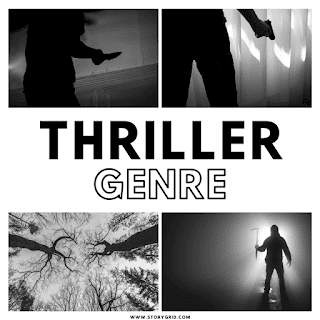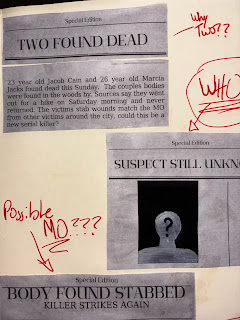Our Genre Blog-Thriller!
Good evening viewers! We’re getting started to research our potential genres for our opening sequence! So for this blog, we will be talking about thrillers!
Common camera angles I have seen in this genre are high and low angles, however high angles are more common as they convey shock and fear in thrillers. Dutch angles are also frequent in thrillers to generate an uneasy feeling or that something is ominous. Eye-level angles are frequently used with zooms to create tension or show emotion, for example, it could be used to show fear in someone's eyes.
Camera movements in thrillers that I have seen most prominently is tracking which could show someone being following. Zooms are also used as they could seem unnatural or artificial, making them perfect for thrillers. Pans and tilts are also used to show scenes and characters, but from what I have seen, tracking and zooms are more common.
Camera shots I have seen in thriller movies are establishing shots, wide shots, medium close-ups, long shots, medium shots, close-ups, extreme close-ups, arial shots, two-shots, and over the shoulder shots. Most scenes are shot with a slow pace to build suspense and linger around important elements of the film.
Common costumes found in thrillers are usually the outfits that the characters would wear based on their circumstances. For example, if the characters were in high school, they would be in casual school outfits. Often, the main antagonist of the thriller will be presented as a normal, unsuspecting person.
While researching and watching thrillers for this blog, I observed a common type of lighting, but I did not know what it was called. After some research, I found that its name was low-key lighting. Low-key lighting is often used in thrillers and other types of scary, suspenseful genres because of the mysterious, dark, and dramatic mood the style creates.
The thriller genre is mostly characterized by the display of intense and suspenseful performances, where actors convey a range of emotions- usually fear
and uncertainty to foster a gripping atmosphere. The characters' acting and success of the film rely on their ability to maintain a sense of unpredictability and tension while facing perilous situations.
Sets are designed to be one of the main foundations of the eerie feel in thrillers. Dark and atmospheric environments are most common. Locations also often include confined spaces, isolated settings, or wide and open urban landscapes that evoke a vulnerable feeling. The set also works together with lighting to create a foreboding ambiance.
Common editing techniques include cross-cutting, flashbacks and flashforwards, jump cuts, montages, shot-reverse shots, and cutaways.
These are mostly used in a way to continue and build that sense of urgency, suspense, and tension. They may also be used to reveal important information about a character or disorient viewers.
Sound elements included are ambient sound, non-diegetic sounds like music, silence, dialogue, jump scares with sudden and loud contrasts in volume, and sound motifs. These elements are employed to create a sense of urgency or mystery.
Dialogue is very important, as what is said- or left unsaid- contributes greatly to the development of the plot and suspense. Ambient sounds are usually heard in the form of creaking doors, footsteps, or distant whispers which make the viewers feel uneasy.
Some examples of thrillers are Five Nights at Freddy's, The Silencing, Happy Death Day, and Killers of the Flower Moon.
If this were my genre, I would like to employ as many of the editing techniques and acting as I could. I really like the delivery of lines of the actors in thrillers that I have watched, and it would be fun to get to recreate this.
Some elements I am not a fan of are the props and makeup. This is not because I do not find them interesting, it is simply because I feel they are a bit more difficult to get right or to do justice. No one in my group is any sort of makeup artist, so getting this aspect down perfectly would be a challenge. Also with the props, they would be challenging to both create and employ. A lot of strategy and skill goes in to the placement and creation of props in the film industry and replicating that in our film would be difficult.



Comments
Post a Comment